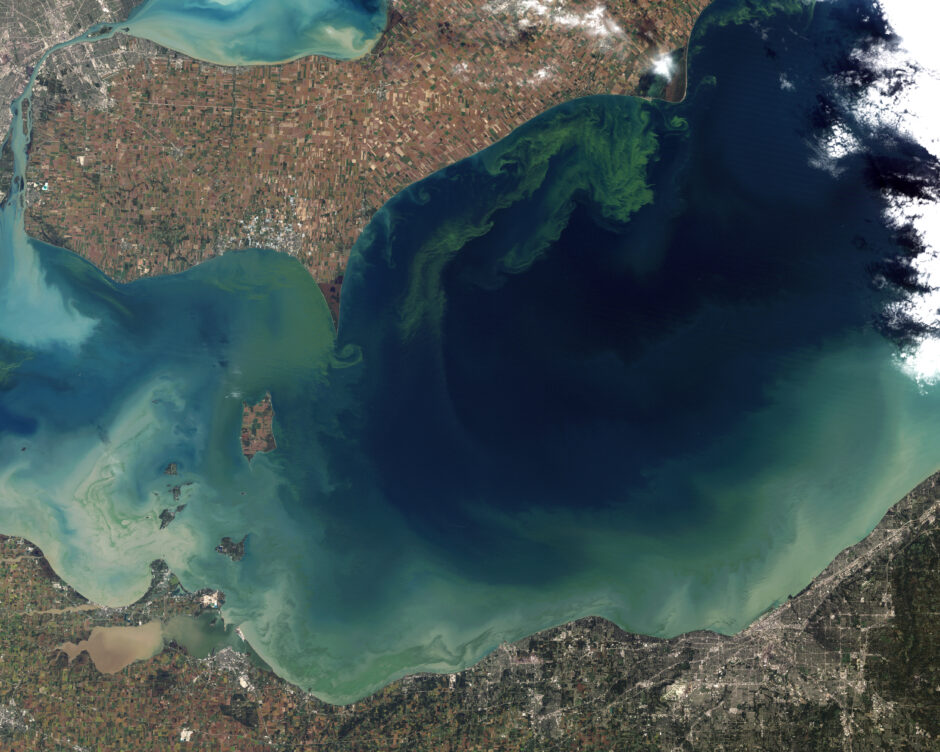Habitat Suitability for Invasive Carp in the Great Lakes Region
 Lake Erie contains enough blue green algae to sustain a population of invasive carp. (Credit: NASA Earth Observatory via Flickr CC BY 2.0)
Lake Erie contains enough blue green algae to sustain a population of invasive carp. (Credit: NASA Earth Observatory via Flickr CC BY 2.0)Research in the Great Lakes region has been dominated by invasive species management and monitoring algal blooms. The Great Lakes are under the constant threat of several invasive species. Yet, one of the most popular and concerning to the scientific community are invasive carp, as the species are known to reshape food webs. In addition to invasive carp, sea lamprey and zebra/quagga mussels have already destabilized the natural balance in the region.
The Great Lakes are most populated by bighead and silver carp, two species of invasive carp, sometimes referred to as Asian carp. In addition to their ecological effects, both are known to cause damage to angling equipment due to their size and behavior. Anglers hoping to catch smaller fish may accidentally lure a 70 lbs bighead, damaging their rod or net. Silver carp are also known to jump out of the water when frightened—injuring boat riders and possibly the vessel itself.
Invasive Carp in the Great Lakes
While invasive carp are herbivores, they occupy valuable habitat space in aquatic systems and outcompete native species. The Great Lakes represent an ideal habitat for carp, with a surplus of food and expansive waters and, unsurprisingly, the carp have migrated up into the basin. Fortunately, the Michigan Invasive Species Program has found that invasive carp have only been found in low numbers by surveys thus far.
Researchers monitoring the spread of the fish are particularly concerned about the suitability of the environment should the species establish a real foothold in the region. Lake Erie’s annual blooms in its western basin and the blooms appearing across the Great Lakes region would provide ample food for the fish, according to a 2015 USGS study.
The study used satellite imagery to determine algae concentrations without performing timely and expensive in-situ sampling. They also used biogenetics to estimate how big the invasive carp will grow under such blooms. The study created a model that examined both variables in order to consider how the invasive carp would fare in the basin.
“Using our study, we were able to show that Lake Erie, in fact, provides a very large area of adequate food for bighead and silver carp,” said Karl Anderson, lead author of the paper.
Of course, the results are limited in that the satellite imagery only examines blooms on the surface and will require more in-depth sampling and monitoring. “When it comes to our predictions here, we are literally just scratching the surface,” states Anderson.
Conclusion
In addition to the non-toxigenic blooms, Lake Erie experiences multiple harmful algal blooms caused by cyanobacteria. These blooms create a multitude of problems for native species and the aquatic system—they are also known to be the cause of several health problems in humans. A silver lining, however, is that it seems even Asian carp won’t eat the harmful algal blooms, according to GreatLakesNow.
While the invasion of carp has been largely staved off in recent years, the threat of them establishing themselves in the ecosystem like other invasives (sea lamprey or round goby) has loomed over the lakes for years as resource managers across the various tributaries combat the spread. Using models like those established by the 2015 study and related research can help managers get ahead of the problem and plan for the scenario.


Pingback: Research Brief: Understanding Aquatic Invasive Species Characteristics and Impacts in the Great Lakes - Lake Scientist